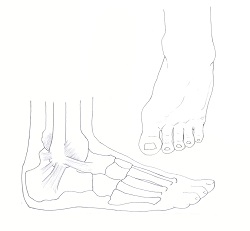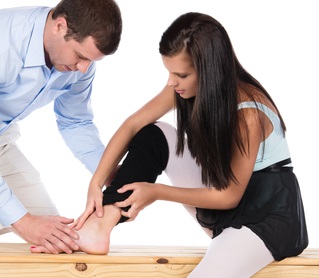Ankle sprains are such a common dance injury. Let’s look at what a strain is, how we can prevent a strain and what we should do to recover.
By Leigh Schanfein of Dance Informa.
The human body contains more than 200 bones. To keep us from wobbling around like disjointed puppets, bones are held together with other bones across joints by bands of tissue called ligaments. Ligaments are made of collagen fibers, which allow little to no movement because they support and protect the integrity of the joint against excessive movement. Ligaments are often confused with tendons, but let’s keep it straight: ligaments connect bone to bone while tendons connect muscle to bone!
What is a sprain? A sprain is an injury to a ligament where the ligament gets over-stretched. In more severe sprains, the ligament suffers from a partial or a complete tear.
How do I know if I might have suffered from a sprain? A sprain occurs at a joint and it is usually the result of excessive movement at that joint, such as a twist, bend, or the feeling of forces going in the wrong direction. It might be associated with an immediate sharp pain or even an audible “pop.”
If I think I have a sprain, how should I treat it? Dr. Hillary Pane, a former ballerina and current contemporary dancer who has had her share of ankle sprains, recommends following PRICE:
Protect – wear a hard brace if the location of the joint allows.
Rest – stay off the affected limb and try not to move the joint.
Ice – ice for up to 20 minutes at a time.
Compression – use a wrap to put even pressure on the area.
Elevation – elevate the joint to assist blood flow out of the affected limb.
If the pain, discomfort, or swelling persists, or if you cannot put weight on the affected limb without pain, a visit to your doctor is recommended to make sure the sprain is not serious. Your doctor may wish to take an x-ray or imaging such as MRI to confirm diagnosis, making sure there is no damage to the bone for example, and to rule out a tear.

Ankle sprain diagram by Leigh Schanfein.
If I do have a sprain, how is it treated? Minor sprains will simply take time to heal. The ligament can recover from over stretching and small tears on its own as you transition from no use, to limited use, to return to dance. Dr. Pane says it will start to feel better after about two weeks, and significantly better in about four to six weeks. Extended immobilization or surgery would only be required in the most extreme cases where there is a complete tear and/or major loss of joint stability.
Give yourself time to recover, regain strength, and slowly work on flexibility and coordination – re-injury after a sprain is very likely since not only will you have lost strength, your proprioception, or the ability for your body to recognize the angle of the joint, will be affected. This is why physical therapists and athletic trainers do not just do strength and flexibility training, they also work with patients on neuromuscular rehabilitation. And Dr. Pane warns that dancers should not become dependent on a brace, and should instead begin a program of intensive therapy with a physical therapist or athletic trainer once the ligament has tightened post-injury.
Prevention is best – how can I prevent a sprain? The two best predictors of a sprain are having suffered from that sprain before and poor proprioception. You can improve your proprioception by working on balance and knowledge of joint angle with the eyes closed (no visual feedback), looking in the mirror (specific visual feedback), and performing exercises on unstable surfaces like foam, balance boards, and inflatable balls (challenging proprioception). Also work on strengthening the muscles used in stabilizing joints rather than just the main agonist movers. Remember, if you’ve had previous sprains it is going to be even more important to rehabilitate your proprioceptive acuity to help prevent repeat sprains.
One of the most common injuries dancers experience is the lateral ankle sprain. This occurs when the ankle rolls outward so pressure goes to the outer edge of the foot and ankle, and the ligaments on that outer side are over-stretched, thus the sprain. It could involve any of the ligaments that serve to stabilize the ankle including those that connect the outer leg bone (fibula) to the heel bone (calcaneus) and other foot bones. Ankle sprains are often sustained from landing a jump improperly or landing on an object or uneven surface causing the ankle to roll. They are also more common amongst female ballet dancers due to working en pointe and having more opportunity to potentially fatigue the ankle, lose balance, or mis-step while in plantar flexion (full pointe).
PRICE is an update of the acronym RICE now in use because, as Dr. Pane suggests, a rigid support for the ankle is recommended rather than soft braces or wraps, which are associated with re-injury during the time when recovery should be happening. For an ankle sprain, she recommends the MalleoLoc because it is one of the few ankle braces that rests the most commonly injured ligament, the ATFL. It is also thin enough to wear in or over a dance shoe for early return to class.
Dr. Pane reminds us that it is particularly important to pick a physician who understands the dancer when it comes to ankle injuries. “Dancers have a unique use of the ankle and foot that requires much more strength, precision, and range of motion and even torque in planes of motion that are not common to other athletes…If the dancer does not feel the physician listens or appreciates his/her needs, the dancer should not hesitate to seek a second opinion.”
For a closer look at ankle sprains, check out the American Family Physician’s update on acute ankle sprains.
Hillary Pane, MD, is a board certified family physician and psychiatrist in private practice in Tulsa, Oklahoma. Dr. Pane has no financial disclosures.
Photo: © Handmademedia | Dreamstime.com















